Because of the high demand for grants in the field of arts and culture, higher priority is given to projects that are innovative, will have a broad impact, show potential for creating new links and which have a strong educational content. Artistic exchanges / residencies are particularly encouraged.
Examples:
| |
|
Our grant helped Birmingham’s Ikon Gallery to present the first UK retrospective of work by acclaimed Japanese artist Atsuko Tanaka (1932 - 2005). Very early collage pieces were shown alongside iconic installations such as Electric Dress (1956).
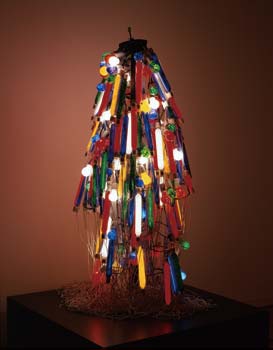 |
|
|
| Atsuko Tanaka, Electric Dress (1956, reconstructed in 1986) Vinyl paint on light bulbs, electric cords and control console Courtesy Takamatsu City Museum of Art © Ryoji Ito |
|
|
|
|
| |
|
Rebecca Salter is a London-based artist who studied in Japan at Kyoto City University for the Arts and has continued her involvement with the country and the culture since returning to the UK.
While conducting research for her two books on Japanese woodblock,
Japanese Woodblock Printing and Japanese Popular Prints, Rebecca Salter became aware that many of the craftsmen she was visiting were retiring and not being replaced by a trained apprentice. She decided to try and film interviews with as many as possible to preserve their stories and provide a record of their skills for the future.
Rebecca Salter commented: ďBecause so many of the craftsmen were elderly, it was important that the project got under way very quickly and the generous grant from GBSF made that possible.Ē
The filmed interviews (a total of nearly 40 hours) will be lodged with a museum as a free resource for future generations. There is also a possibility (if further funding becomes available) that it will be put online.
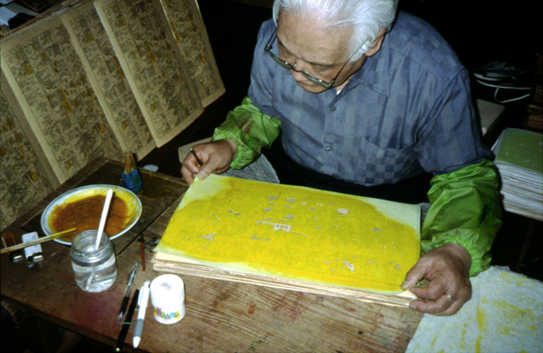 |
|
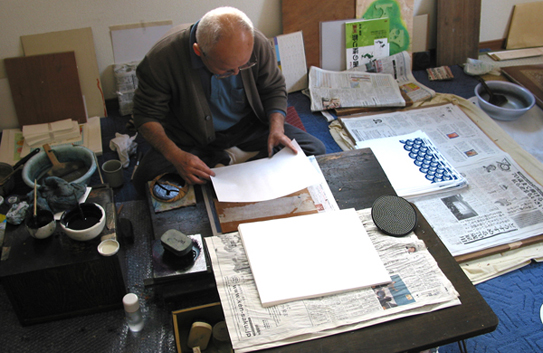 |
| Matsui Shigeo - Kyoto karuta maker |
|
Matsuzaki Keizaburo - Tokyo printer |
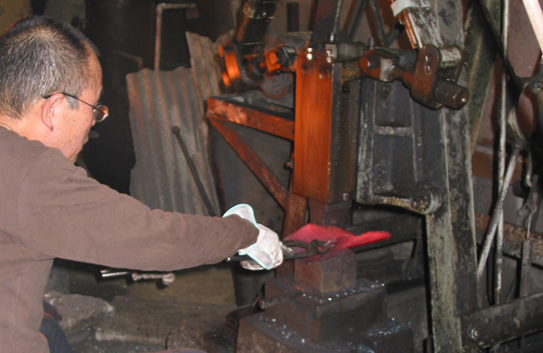 |
|
|
Shimizu Hamono - carving tool maker
All photos by Rebecca Salter |
|
|
|
|
| |
| |
The Wales Millennium Centre has strong links with Japan and, with funding from the Foundation, commissioned a series of sumi-e art works by Japanese artist Takumasa Ono for permanent display in its new Japan Room. The aim was to introduce this art form and to make it more accessible to the Welsh public. The Centre also organised a number of outreach events hosting a series of sumi-e workshops for adults and children and presenting a series of live performances linked to Japanese culture.
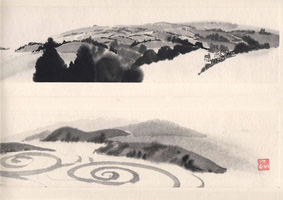 |
|
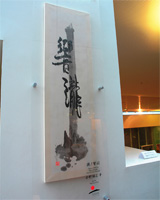 |
| Early sketches of sumi-e produced by Takumasa Ono for the Japan Room. |
|
One of the final sumi-e art works. |
|
| |
| |
| |
One of the most effective ways of promoting cultural understanding is through the medium of film and 2010 gave us a welcome opportunity to partner a number of organisations in presenting the best of contemporary Japanese cinema in the UK. The Japan Foundationís Touring Film Programme showcased the breadth of new talent since the 1990s while Jasper Sharp launched the Zipangu Film Festival at venues in London and countrywide, the first UK film festival devoted entirely to Japanese cinema. The Glasgow Short Film Festival staged a retrospective of Cannes Festival winner, Naomi Kawase, whose short documentary, fiction and experimental films had never been released in the UK before.
 |
|
|
| In November 2010, Hisayasu Satoís Love & Loathing & Lulu & Ayano received its world premiere in London as part of the Zipangu Film Festival |
|
|
|
| |
| |
| |
Japanese popular culture continues to have a huge impact overseas, particularly film, manga and popular music. It Came From Japan, a collective dedicated to making the UK more accessible to Japanese musicians, received our grant to organise two showcase UK tours for Japanese bands.
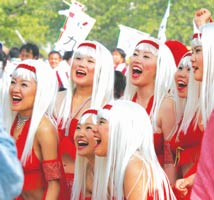 |
|
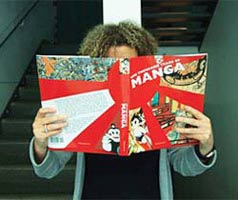 |
|
 |
| Japanese street culture Photography by El Fotopakismo via flickr.com by way of the Creative Commons license |
|
Reading manga at the Lighthouse Gallery Glasgow's Japanese Saturday. Photo: The Lighthouse Trust |
|
Japanese band, Bespa Kumamero, performing in the UK. Photo: Roxanne Royer |
|
| |
| |
| |
A modest grant was given to Scottish carpenter, Cormac Seekings to enable him to participate in a gathering in Japan of European and Japanese carpenters, Chisana Kezurokai 2010, the first of its kind on minka house construction, carpentry and traditional building skills. The main event was the building of a tea-house and a European Pavilion that drew on traditional aspects of timber framing and used only hand tools and no electricity. He learnt much from communicating with young handcrafters on technical issues and from working with Japanese master carpenters who are keeping traditional building skills alive. On his return, he was able to impart this knowledge to his students and to self-builders in Scotland. He is now working on establishing a non-profit Trust for Forest Crofting and Low-impact Carpentry Skills Training.
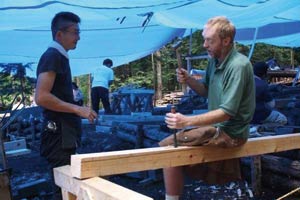 |
|
|
| Chisana Kezurokai, Yamanashi Pref. Shohei Araki offering guidance to Cormac in his morticing of a tea-house timber. Photo: Nicola Wood |
|
|
|
| |
| |
| |
We awarded a grant to Rouge28 Theatre towards a new solo production, Urashima Taro. Fusing bunraku style puppetry with kamishibai, story telling and mask work, the piece was performed and devised by artist, Aya Nakamura, at Londonís Shunt Lounge before touring further UK venues. As a combination of Japanese traditional art forms and contemporary methodology and approaches it did much to increase awareness of Japanese contemporary theatre in the UK.
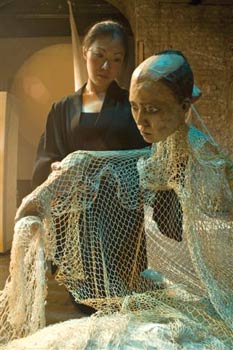 |
|
|
| The ancient tale of 'Urashima Taro' brought to life by Aya Nakamura of Rouge28. Photo: Monika Kita |
|
|
|
| |
| |
| |
The Foundation was delighted to make an award to ‘Stretch’, an arts charity that encourages lifelong learning and participation in the arts among socially excluded groups. In order to facilitate access by prisoners and mental health patients, unable to visit museums and galleries, it developed with the Victoria and Albert Museum and with the Royal Armoury a series of materials, CD roms and virtual tours of their Japanese collections.
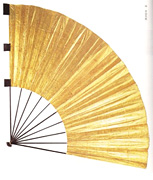
|
| |
| |
| |
The Whitworth Art Gallery at the University of Manchester houses a collection of 530 Japanese woodblock prints that includes works by some of the most important masters of Japanese printmaking such as Hiroshigeís Sudden Shower at Atake, Hokusaiís Kintai Bridge, Suo Province and Keisai Eisenís Courtesan Triptych. 85% of the collection was in need of conservation and re-interpretation and we were pleased to give the Gallery a grant towards the materials needed and for the creation of work-placements for conservation interns.
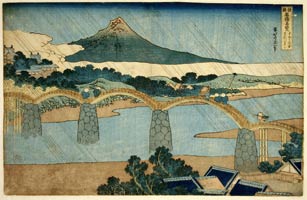 |
|
|
| Kintai Bridge, Suo Province, Katsushika Hokusai (1760 - 1849). Photo: courtesy of The Whitworth Art Gallery, The University of Manchester |
|
|
|
| |
| |
| |
Playbox Theatre received two grants to enable them to stage a performance of the noh play Haito the Tree Wizard in local schools in Warwickshire and later to take younger members of Playbox to Tokyo to perform children’s drama in schools in Japan.
| Warwick's Playbox Theatre Company performing a new Noh play 'Haito the Tree Wizard' for local schools. Photo: Andy Brining of Brining Photography. |
|
| |
| |
| |
The Foundation was pleased to give a grant to the Serpentine Gallery towards its 2009 Pavilion, designed by Japanese architects Kazuyo Sejima and Ryue Nishizawa of SANAA. 'A delightful structure... of all the Serpentine pavilions, SANAA's ranks as one of the best'. (The Guardian)
The duo went on to win the 2010 Pritzker Prize, one of the most coveted awards in architecture.
| Serpentine Gallery Pavilion 2009 Designed by Kazuyo Sejima + Ryue Nishizawa/ SANAA © 2009 Kazuyo Sejima + Ryue Nishizawa / SANAA. Photo: Iwan Baan |
|
|
|
| |
| |
| |
A grant to Jannette Cheong helped towards the development costs for costumes and masks for an innovative production in English of classic and contemporary Noh theatre. In the play Kiyotsune, a western artist, acts as koken (stage assistant) to the Japanese shite in this unique east-west collaboration.
|
| |
| |
| |
The Foundation’s support for publications is an important element in achieving its aim of spreading wider mutual knowledge of Japanese and British cultures. We give financial support to UK publishers wishing to publish a work on or about Japan or towards the author’s research costs in Japan. Books published over recent years with assistance from The Great Britain Sasakawa Foundation have included:
- A manga version of the life and works of Lafcadio Hearn published by Boychild Productions
- Doing Business with the Japanese by Geoffrey Bownas, David Powers, Christopher Hood and individual contributors, published by Direct Image
- Japan through Writers’ Eyes by Elizabeth Ingrams, published by Eland Publishing Ltd
- Reciprocal Frame Architecture by Olga Popovic Larsen published by Architectural Press (An imprint of Elsevier)
- The Business, Life and Letters of Frederick Cornes – Aspects of the Evolution of Commerce in Modern Japan, 1861-1910 by Peter N Davies, published by Global Oriental Ltd
- Land of the Samurai – Aberdeen’s Japanese Treasures, published by Aberdeen City Council
- The Japanese Sword – The Soul of the Samurai by Gregory Irvine, published by V & A Publications
- Traditional Folk Music in Modern Japan by Dr David Hughes, published by Global Oriental
- The Japanese Consumer: An Alternative Economic History of Modern Japan by Dr Penelope Francks, published by Cambridge University Press
- Publication of Biographical Portraits by the Japan Society, published by Global Oriental Ltd.
- Tokyo, Love, Hello by Chris Steele Perkins, published by Editions Intervalles/Magnum Photos
The Foundation also gives an annual award (the Sasakawa Prize) through the Society of Authors to an interpreter of Japan to the English-speaking world. The author is chosen by a special panel of judges from the Society of Authors.
Recent awards have been
- Chris Bradbury for a childrenís book 'Young Samurai – The Way of the Warrior', published by Puffin Books, to Helen McCarthy for a new work on manga artist, animator and producer, Osamu Tezuka and to ZoŽ Marriott for her novel 'Shadows on the Moon', published by Walker Books.
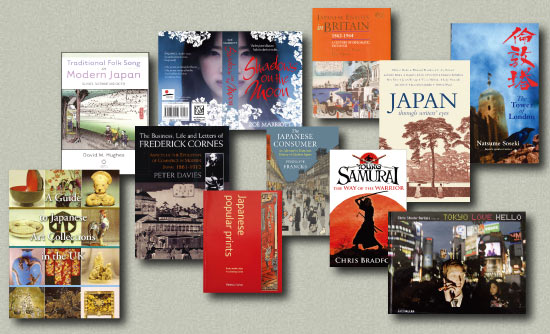
|
|